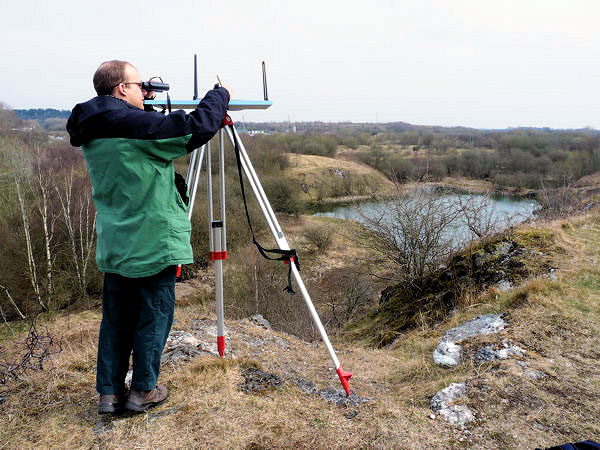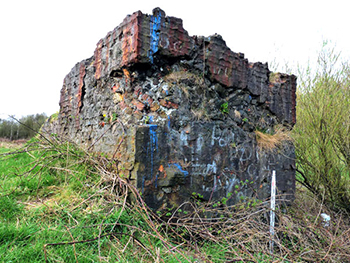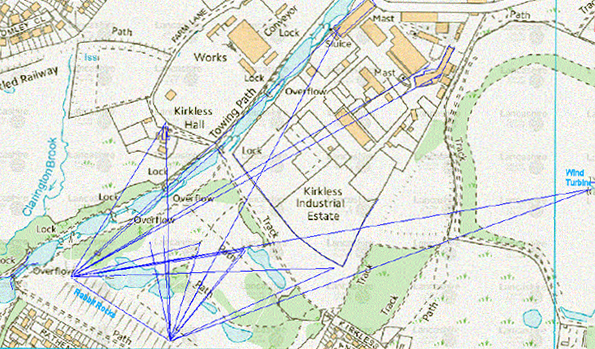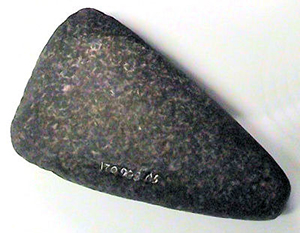
Last month a team of four from the Society began to survey this site which lies to east of the Leeds and Liverpool Canal in Higher Ince. This was our second visit here (an earlier attempt the week before had to be abandoned due to the bitterly cold weather). This time we were able to establish two surveying stations on the Rabbit Rocks 200 metres apart. Using our new plane table equipment, we proceeded to survey various features in the landscape.
 The first features were specifically selected as reference points that could be identified later on current maps. They included the canal bridge, Kirkless Hall itself, the east corner of the industrial estate fence and some building inside the industrial estate - all of which could be used to key in our survey. The south east corner of the fence was particularly challenging as it could not be seen directly. However Eric was able to improvise using an extended survey staff with an orange plastic bag on top which could just be seen above the trees (binoculars and walkietalkies proved to be handy tools on a site as large as this). We also recorded some features of the old works that still survive on the ground, i.e. stone blocks, brick foundations and a massive rectangular lump of iron and brick. This peculiar two metre high feature, standing like a castle bastion on the edge of a medieval lake, seems to have been produced by pouring molten iron inside a rubble filled room. When the room was demolished, the impressions of its walls were left in the iron.
The first features were specifically selected as reference points that could be identified later on current maps. They included the canal bridge, Kirkless Hall itself, the east corner of the industrial estate fence and some building inside the industrial estate - all of which could be used to key in our survey. The south east corner of the fence was particularly challenging as it could not be seen directly. However Eric was able to improvise using an extended survey staff with an orange plastic bag on top which could just be seen above the trees (binoculars and walkietalkies proved to be handy tools on a site as large as this). We also recorded some features of the old works that still survive on the ground, i.e. stone blocks, brick foundations and a massive rectangular lump of iron and brick. This peculiar two metre high feature, standing like a castle bastion on the edge of a medieval lake, seems to have been produced by pouring molten iron inside a rubble filled room. When the room was demolished, the impressions of its walls were left in the iron.
Our survey data has now been plotted on a modern map (see below) and the next stage is to overlay this information onto older maps showing detail of the iron works at its height. We should then be able to pin-point exactly where specific features were located on the ground - this is in spite of all the intensive landscaping which has taken place here over recent year.
If you want to get involved in this project contact Eric or myself at the meeting.

Thunderstones are go
 A few years ago this Neolithic stone axe was found by Prestwich Archaeology Group whilst excavating a timber-framed cruck cottage at Rainsough Brow (which is about half way between Manchester and Bolton). What was a prehistoric stone axe doing in a medieval building you may ask. Brian Sitch of Manchester Museum is convinced it was being used as a Thunderstone. Apparently in Greek and Roman times people didn't know when they found a prehistoric stone axe that it was a piece of archaeology. They understood it to be a fossilised thunderbolt and called it a keraunos. Working on the principle that lightning never strikes the same place twice, it made sense to them to place it in the roofs of buildings to act as a charm to ward off lightning. A Neolithic stone axe head found in a Medieval building at Treasury Green in London is one example of this practice. However, if the Prestwick one can be proved to be another, it will be the only example to be found in the North West. The stone is currently on display in the Bury Art Museum, however Brian is keen to arrange a long term loan so that he can display it in Manchester Museum's Ancient World exhibition. You can read more about the background to this strange practice on the museum's blog site here.
A few years ago this Neolithic stone axe was found by Prestwich Archaeology Group whilst excavating a timber-framed cruck cottage at Rainsough Brow (which is about half way between Manchester and Bolton). What was a prehistoric stone axe doing in a medieval building you may ask. Brian Sitch of Manchester Museum is convinced it was being used as a Thunderstone. Apparently in Greek and Roman times people didn't know when they found a prehistoric stone axe that it was a piece of archaeology. They understood it to be a fossilised thunderbolt and called it a keraunos. Working on the principle that lightning never strikes the same place twice, it made sense to them to place it in the roofs of buildings to act as a charm to ward off lightning. A Neolithic stone axe head found in a Medieval building at Treasury Green in London is one example of this practice. However, if the Prestwick one can be proved to be another, it will be the only example to be found in the North West. The stone is currently on display in the Bury Art Museum, however Brian is keen to arrange a long term loan so that he can display it in Manchester Museum's Ancient World exhibition. You can read more about the background to this strange practice on the museum's blog site here.
Next Meeting
Wednesday 1st May - in the Standish Suite at the Brocket Arms (7.30pm as usual). This month we have Dorothy Kazer from Leyland who will be giving us a talk on the history of Leyland with particular reference to the Farington and Charnock families. Both these families were and ancient landed gentry. The Faringtons lived at Farington Hall until it was lost to them in the mid 16th century. They moved to Old Worden Hall on what was the ROF site at Euxton, but abandoned this in favour of Shaw Hall in the early 18th century (in what is now called Worden Park). The hall was rebuilt and renamed as Worden Hall in the mid 19th century. The Hall and Park were eventually sold to the council in 1950. This sounds like a fascinating story so hope to see you there, BA.
|



